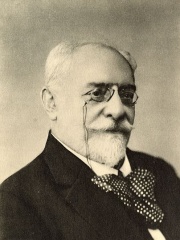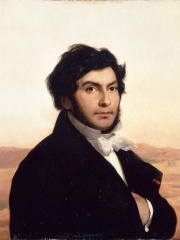
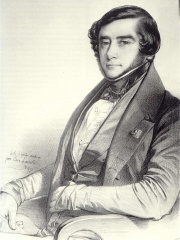
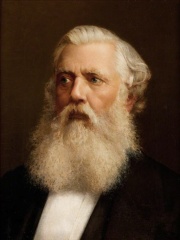
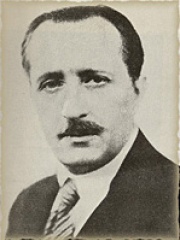
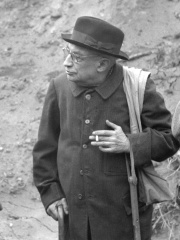
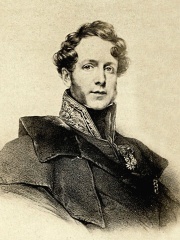
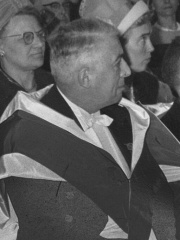
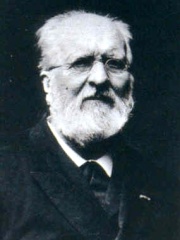
The Most Famous
ARCHAEOLOGISTS from France
This page contains a list of the greatest French Archaeologists. The pantheon dataset contains 151 Archaeologists, 17 of which were born in France. This makes France the birth place of the 4th most number of Archaeologists behind Germany, and United States.
Top 10
The following people are considered by Pantheon to be the top 10 most legendary French Archaeologists of all time. This list of famous French Archaeologists is sorted by HPI (Historical Popularity Index), a metric that aggregates information on a biography's online popularity. Visit the rankings page to view the entire list of French Archaeologists.

1. Jean-François Champollion (1790 - 1832)
With an HPI of 80.11, Jean-François Champollion is the most famous French Archaeologist. His biography has been translated into 74 different languages on wikipedia.
Jean-François Champollion (French: [ʒɑ̃ fʁɑ̃swa ʃɑ̃pɔljɔ̃]), also known as Champollion le jeune ('the Younger'; 23 December 1790 – 4 March 1832), was a French philologist and orientalist, known primarily as the decipherer of Egyptian hieroglyphs and a founding figure in the field of Egyptology. Partially raised by his brother, the scholar Jacques Joseph Champollion-Figeac, Champollion was a child prodigy in philology, giving his first public paper on the decipherment of Demotic in his late teens. As a young man he was renowned in scientific circles, and read Coptic, Ancient Greek, Latin, Hebrew and Arabic. During the early 19th century, French culture experienced a period of 'Egyptomania', brought on by Napoleon's discoveries in Egypt during his campaign there (1798–1801), which also brought to light the trilingual Rosetta Stone. Scholars debated the age of Egyptian civilization and the function and nature of the hieroglyphic script, which language if any it recorded, and the degree to which the signs were phonetic (representing speech sounds) or ideographic (recording semantic concepts directly). Many thought that the script was used only for sacred and ritual functions, and that as such it was unlikely to be decipherable since it was tied to esoteric and philosophical ideas, and did not record historical information. The significance of Champollion's decipherment was that he showed these assumptions to be wrong, and made it possible to begin to retrieve many kinds of information recorded by the ancient Egyptians. Champollion lived in a period of political turmoil in France, which continuously threatened to disrupt his research in various ways. During the Napoleonic Wars, he was able to avoid conscription, but his Napoleonic allegiances meant that he was considered suspect by the subsequent Royalist regime. His own actions, sometimes brash and reckless, did not help his case. His relations with important political and scientific figures of the time, such as Joseph Fourier and Silvestre de Sacy, helped him, although in some periods he lived exiled from the scientific community. In 1820, Champollion embarked in earnest on the project of the decipherment of hieroglyphic script, soon overshadowing the achievements of British polymath Thomas Young, who had made the first advances in decipherment before 1819. In 1822, Champollion published his first breakthrough in the decipherment of the Rosetta hieroglyphs, showing that the Egyptian writing system was a combination of phonetic and ideographic signs – the first such script discovered. In 1824, he published a Précis in which he detailed a decipherment of the hieroglyphic script demonstrating the values of its phonetic and ideographic signs. In 1829, he travelled to Egypt where he was able to read many hieroglyphic texts that had never before been studied and brought home a large body of new drawings of hieroglyphic inscriptions. Home again, he was given a professorship in Egyptology but lectured only a few times before his health, ruined by the hardships of the Egyptian journey, forced him to give up teaching. He died in Paris in 1832, 41 years old. His grammar of Ancient Egyptian was published posthumously under the supervision of his brother. During his life as well as long after his death, intense discussions over the merits of his decipherment were carried out among Egyptologists. Some faulted him for not having given sufficient credit to the early discoveries of Young, accusing him of plagiarism, and others long disputed the accuracy of his decipherments. However, subsequent findings and confirmations of his readings by scholars building on his results gradually led to the general acceptance of his work. Although some still argue that he should have acknowledged the contributions of Young, his decipherment is now universally accepted and has been the basis for all further developments in the field. Consequently, he is regarded as the "Founder and Father of Egyptology".

2. Alcide d'Orbigny (1802 - 1857)
With an HPI of 67.84, Alcide d'Orbigny is the 2nd most famous French Archaeologist. His biography has been translated into 37 different languages.
Alcide Charles Victor Marie Dessalines d'Orbigny (French pronunciation: [alsid ʃaʁl viktɔʁ maʁi dɛsalin dɔʁbiɲi]; 6 September 1802 – 30 June 1857) was a French naturalist who made major contributions in many areas, including zoology (including malacology), palaeontology, geology, archaeology and anthropology. D'Orbigny was born in Couëron (Loire-Atlantique), the son of a ship's physician and amateur naturalist. The family moved to La Rochelle in 1820, where his interest in natural history was developed while studying the marine fauna and especially the microscopic creatures that he named "foraminiferans". In Paris he became a disciple of the geologist Pierre Louis Antoine Cordier (1777–1861) and Georges Cuvier. All his life, he would follow the theory of Cuvier and stay opposed to Lamarckism.

3. Austen Henry Layard (1817 - 1894)
With an HPI of 66.33, Austen Henry Layard is the 3rd most famous French Archaeologist. His biography has been translated into 32 different languages.
Sir Austen Henry Layard (; 5 March 1817 – 5 July 1894) was an English Assyriologist, traveller, cuneiformist, art historian, draughtsman, collector, politician and diplomat. He was born to a mostly English family in Paris and largely raised in Italy. He is best known as the excavator of Nimrud and of Nineveh, where he uncovered a large proportion of the Assyrian palace reliefs known, and in 1851 the library of Ashurbanipal. Most of his finds are now in the British Museum. He made a large amount of money from his best-selling accounts of his excavations. He had a political career between 1852, when he was elected as a Member of Parliament, and 1869, holding various junior ministerial positions. He was then made ambassador to Madrid, then Constantinople, living much of the time in a palazzo he bought in Venice. During this period he built up a significant collection of paintings, which due to a legal loophole he had as a diplomat, he was able to extricate from Venice and bequeath to the National Gallery (as the Layard Bequest) and other British museums.

4. Paul Pelliot (1878 - 1945)
With an HPI of 64.17, Paul Pelliot is the 4th most famous French Archaeologist. His biography has been translated into 27 different languages.
Paul Eugène Pelliot (28 May 1878 – 26 October 1945) was a French sinologist and Orientalist best known for his explorations of Central Asia and the Silk Road regions, and for his acquisition of many important Tibetan Empire-era manuscripts and Chinese texts at the Sachu printing center storage caves (Dunhuang), known as the Dunhuang manuscripts. A hyperpolyglot, he spoke 13 Oriental languages, including among othersMandarin and Cantonese , Turkish, Russian, Mongolian, Hebrew, Uzbek, Pashto, and Tagalog, as well as Sanskrit, and even rarer languages such as Uyghur, and extinct languages Sogdian, and Tocharian. He was a student of the Indologist Sylvain Lévi and the archaeologist Édouard Chavannes. Paul Pelliot was a member of the French School of the Far East from 1899 to 1911, where he developed the school’s sinology branch. In 1911, at the age of just 33, a chair in Languages, History, and Archaeology of Central Asia was created for him at the prestigious Collège de France.
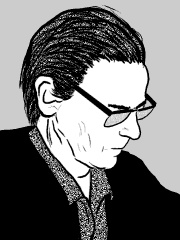
5. André Leroi-Gourhan (1911 - 1986)
With an HPI of 63.45, André Leroi-Gourhan is the 5th most famous French Archaeologist. His biography has been translated into 22 different languages.
André Leroi-Gourhan (; French: [ləʁwa guʁɑ̃]; 25 August 1911 – 19 February 1986) was a French archaeologist, paleontologist, paleoanthropologist, and anthropologist with an interest in technology and aesthetics and a penchant for philosophical reflection.

6. Henri Breuil (1877 - 1961)
With an HPI of 62.83, Henri Breuil is the 6th most famous French Archaeologist. His biography has been translated into 27 different languages.
Henri Édouard Prosper Breuil (28 February 1877 – 14 August 1961), often referred to as Abbé Breuil (French pronunciation: [abe bʁœj]), was a French Catholic priest, archaeologist, anthropologist, ethnologist and geologist. He studied cave art in the Somme and Dordogne valleys as well as in Spain, Portugal, Italy, Ireland, China with Teilhard de Chardin, Ethiopia, British Somali Coast Protectorate, and especially southern Africa.

7. Jacques Boucher de Crèvecœur de Perthes (1788 - 1868)
With an HPI of 60.60, Jacques Boucher de Crèvecœur de Perthes is the 7th most famous French Archaeologist. His biography has been translated into 21 different languages.
Jacques Boucher de Crèvecœur de Perthes (French pronunciation: [ʒak buʃe d(ə) kʁɛvkœʁ də pɛʁt]; 10 September 1788 – 5 August 1868), sometimes referred to as Boucher de Perthes (British English: BOO-shay də PAIRT), was a French archaeologist and antiquary notable for his discovery, in about 1830, of flint tools in the gravels of the Somme valley.

8. André Parrot (1901 - 1980)
With an HPI of 59.70, André Parrot is the 8th most famous French Archaeologist. His biography has been translated into 18 different languages.
André Charles Ulrich Parrot (15 February 1901 – 24 August 1980) was a French archaeologist, Assyriologist, curator, and Lutheran pastor who served as the first president and director of the Louvre Museum in Paris from 1968 through 1972. A specialist in the ancient Near East, Parrot led excavations in Lebanon, Iraq and Syria, and is best known for his discovery of the city of Mari where he led important excavations from 1933 through 1975. He was the husband of the composer Marie-Louise Girod.

9. Louis Laurent Gabriel de Mortillet (1821 - 1898)
With an HPI of 59.32, Louis Laurent Gabriel de Mortillet is the 9th most famous French Archaeologist. His biography has been translated into 21 different languages.
Louis Laurent Gabriel de Mortillet (29 August 1821 – 25 September 1898), French archaeologist and anthropologist, was born at Meylan, Isère.
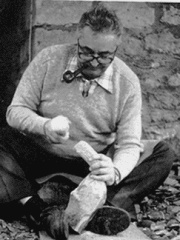
10. François Bordes (1919 - 1981)
With an HPI of 59.15, François Bordes is the 10th most famous French Archaeologist. His biography has been translated into 18 different languages.
François Bordes (French pronunciation: [fʁɑ̃swa bɔʁd] ; December 30, 1919 – April 30, 1981), also known by the pen name of Francis Carsac, was a French scientist, geologist, archaeologist, and science fiction writer.
People
Pantheon has 17 people classified as French archaeologists born between 1703 and 1919. Of these 17, none of them are still alive today. The most famous deceased French archaeologists include Jean-François Champollion, Alcide d'Orbigny, and Austen Henry Layard.
Deceased French Archaeologists
Go to all RankingsJean-François Champollion
1790 - 1832
HPI: 80.11
Alcide d'Orbigny
1802 - 1857
HPI: 67.84
Austen Henry Layard
1817 - 1894
HPI: 66.33
Paul Pelliot
1878 - 1945
HPI: 64.17
André Leroi-Gourhan
1911 - 1986
HPI: 63.45
Henri Breuil
1877 - 1961
HPI: 62.83
Jacques Boucher de Crèvecœur de Perthes
1788 - 1868
HPI: 60.60
André Parrot
1901 - 1980
HPI: 59.70
Louis Laurent Gabriel de Mortillet
1821 - 1898
HPI: 59.32
François Bordes
1919 - 1981
HPI: 59.15
Victor Loret
1859 - 1946
HPI: 58.46
Jean-François Séguier
1703 - 1784
HPI: 57.92
Overlapping Lives
Which Archaeologists were alive at the same time? This visualization shows the lifespans of the 17 most globally memorable Archaeologists since 1700.

